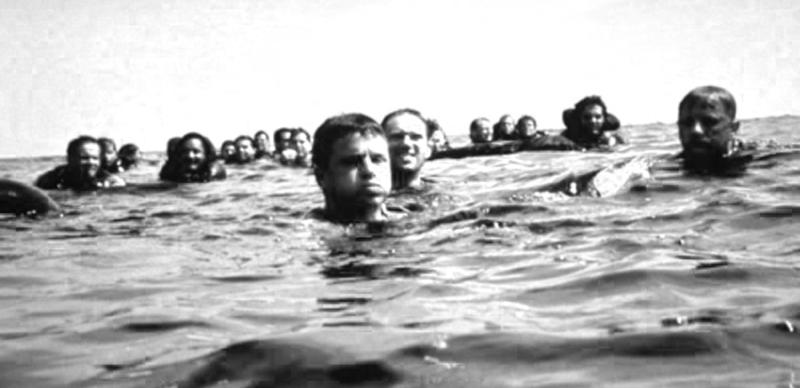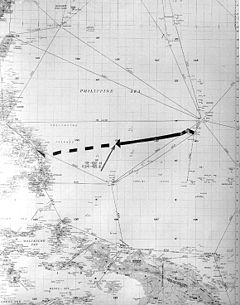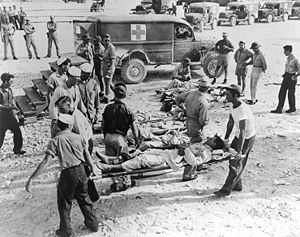This Day In History - USS Indianapolis Sunk in 1945



|
||
|---|---|---|
Pre-invasion bombardment of Okinawa began on 24 March. Indianapolis spent 7 days pouring 8 in (200 mm) shells into the beach defenses. During this time, enemy aircraft repeatedly attacked the American ships. Indianapolis shot down six planes and damaged two others. On 31 March, the ship's lookouts spotted a Japanese fighter as it emerged from the morning twilight and roared at the bridge in a vertical dive. The ship's 20 mm guns opened fire, but within 15 seconds, the plane was over the ship. Tracers converged on it, causing it to swerve, but the enemy pilot managed to release his bomb from a height of 25 ft (7.6 m), crashing his plane into the sea near the port stern . The bomb plummeted through the deck, into the crew's mess hall, down through the berthing compartment, and through the fuel tanks before crashing through the keel and exploding in the water underneath. The concussion blew two gaping holes in the keel which flooded nearby compartments, killing nine crewmen. The ship's bulkheads prevented any progressive flooding. The Indianapolis , settling slightly by the stern and listing to port, steamed to a salvage ship for emergency repairs. Here, inspection revealed that her propeller shafts were damaged, her fuel tanks ruptured, and her water-distilling equipment ruined. But the Indianapolis commenced the long trip across the Pacific to Mare Island under her own power.
Loss
After major repairs and an overhaul, Indianapolis received orders to proceed to Tinian island, carrying parts and the enriched uranium (about half of the world's supply of Uranium-235 at the time) for the atomic bomb Little Boy , which would later be dropped on Hiroshima . [10] Indianapolis departed San Francisco on 16 July. Arriving at Pearl Harbor on 19 July, she raced on unaccompanied, reaching Tinian on 26 July. Indianapolis was then sent to Guam where a number of the crew who had completed their tours of duty were replaced by other sailors. Leaving Guam on 28 July, she began sailing toward Leyte where her crew was to receive training before continuing on to Okinawa to join Vice Admiral Jesse B. Oldendorf 's Task Force 95. At 00:14 on 30 July, she was struck by two Type 95 torpedoes on her starboard bow, from the Japanese submarine I-58 under the command of Mochitsura Hashimoto . The explosions caused massive damage. The Indianapolis took on a heavy list, and settled by the head. Twelve minutes later, she rolled completely over, then her stern rose into the air, and she plunged down. Some 300 of the 1,196 crewmen went down with the ship. With few lifeboats and many without lifejackets, the remainder of the crew were set adrift awaiting rescue. [11]

Navy command had no knowledge of the ship's sinking until survivors were spotted three and a half days later. At 10:25 on 2 August a PV-1 Ventura flown by Lieutenant Wilbur "Chuck" Gwinn and copilot Lieutenant Warren Colwell spotted the men adrift while on a routine patrol flight. [12] Of the 880 that survived the sinking, only 321 men came out of the water alive; 317 ultimately survived. They suffered from lack of food and water (some found rations such as Spam and crackers amongst the debris ), exposure to the elements ( hypothermia , dehydration , hypernatremia , photophobia , starvation and dementia ), severe desquamation , and shark attacks , while some killed themselves and/or one another in various states of delirium and hallucinations. [13] The Discovery Channel stated in Shark Week episodes "Ocean of Fear" that the Indianapolis sinking resulted in the most shark attacks on humans in history, and attributes the attacks to the oceanic whitetip shark species. Tiger sharks might have also killed some of the survivors. The same show attributed most of the deaths on Indianapolis to exposure, salt poisoning and thirst , with the dead being dragged off by sharks. [14]
Gwinn immediately dropped a life raft and a radio transmitter. All air and surface units capable of rescue operations were dispatched to the scene at once. A PBY Catalina seaplane under the command of Lieutenant R. Adrian Marks was dispatched to lend assistance and report. [12] En route to the scene, Marks overflew Cecil J. Doyle and alerted her captain, future U.S. Secretary of the Navy W. Graham Claytor, Jr., of the emergency. On his own authority, Claytor decided to divert to the scene.
Arriving hours ahead of Doyle , Marks' crew began dropping rubber rafts and supplies. Having seen men being attacked by sharks, Marks disobeyed standing orders and landed on the open sea. He began taxiing to pick up the stragglers and lone swimmers who were at the greatest risk of shark attack. [12] Learning the men were the crew of Indianapolis , he radioed the news, requesting immediate assistance. Doyle responded while en route. When Marks' plane was full, survivors were tied to the wings with parachute cord, damaging the wings so that the plane would never fly again and had to be sunk. [12] Marks and his crew rescued 56 men that day. [12]
The Doyle was the first vessel on the scene. [12] Homing on Marks's Catalina in total darkness, Doyle halted to avoid killing or further injuring survivors, and began taking Marks' survivors aboard. Disregarding the safety of his own vessel, Captain Claytor pointed his largest searchlight into the night sky to serve as a beacon for other rescue vessels. [12] This beacon was the first indication to most survivors that rescuers had arrived. [12]
The destroyers Helm , Madison , and Ralph Talbot were ordered to the rescue scene from Ulithi, along with destroyer escorts Dufilho , Bassett , and Ringness of the Philippine Sea Frontier . They continued their search for survivors until 8 August.
Navy failure to learn of the sinking
Operations plotting boards were kept at the Headquarters of Commander Marianas on Guam and of the Commander Philippine Sea Frontier on Leyte. On these boards, the positions of all vessels of which the headquarters was concerned were plotted. However, for ships as large as the Indianapolis , it was assumed that they would reach their destinations on time, unless reported otherwise. Therefore, their positions were based on predictions, and not on reports. On 31 July, when she should have arrived at Leyte, Indianapolis was removed from the board in the headquarters of Commander Marianas. She was also recorded as having arrived at Leyte by the headquarters of Commander Philippine Sea Frontier. Lieutenant Stuart B. Gibson, the Operations Officer under the Port Director, Tacloban, was the officer responsible for tracking the movements of Indianapolis . The non-arrival of that vessel on schedule was known at once to Lieutenant Gibson who failed to investigate the matter and made no immediate report of the fact to his superiors. [15]
The Indianapolis sent distress calls before sinking. Three stations received the signals; however, none acted upon the call. One commander was drunk, another had ordered his men not to disturb him and a third thought it was a Japanese prank. [16] For a long time the Navy denied that a distress call had been sent. The receipt of the call came to light only after the release of declassified records.
Immediately prior to the attack, the seas had been moderate, the visibility fluctuating but poor in general, and Indianapolis had been steaming at 17 kn (20 mph; 31 km/h). When the ship did not reach Leyte on the 31st, as scheduled, no report was made that she was overdue. This omission was due to a misunderstanding of the Movement Report System . Captain Charles B. McVay III , who had commanded Indianapolis since November 1944, survived the sinking, and was with those rescued days later. In November 1945, he was court-martialed and convicted of "hazarding his ship by failing to zigzag ." Several things about the court-martial were controversial. There was evidence that the Navy itself had placed the ship in harm's way, in that McVay's orders were to "zigzag at his discretion, weather permitting." Further, Mochitsura Hashimoto , commander of I-58 , testified that zigzagging would have made no difference. [17]
Fleet Admiral Chester Nimitz remitted McVay's sentence and restored him to active duty. McVay retired in 1949. [18] While many of Indianapolis 's survivors said McVay was not to blame for the sinking, the families of some of the men who died thought otherwise - "Merry Christmas! Our family's holiday would be a lot merrier if you hadn't killed my son", read one piece of hate mail. [19] The guilt that was placed on his shoulders mounted until he committed suicide in 1968, using his Navy-issue revolver. McVay was discovered on his front lawn with a toy sailor in one hand. [19]
In October 2000, the United States Congress passed a resolution that Captain McVay's record should state that "he is exonerated for the loss of Indianapolis ." President Bill Clinton signed the resolution. [20] The resolution noted that although several hundred ships of the U.S. Navy were lost in combat in World War II , McVay was the only captain to be court-martialed for the sinking of his ship. [21] In July 2001, the Secretary of the Navy ordered McVay's record cleared of all wrongdoing. [22] [23]




And this is the scary story Captain Quint told in "Jaws"